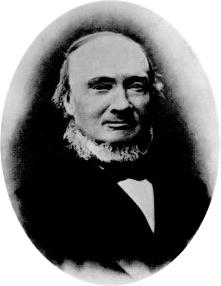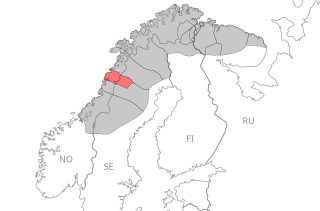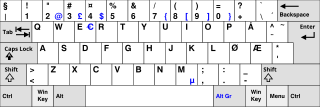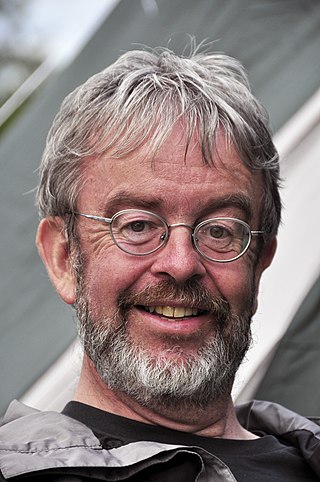
Ivar Andreas Aasen was a Norwegian philologist, lexicographer, playwright, and poet. He is best known for having assembled one of the two official written versions of the Norwegian language, Nynorsk, from various dialects.

Norwegian is a North Germanic language from the Indo-European language family spoken mainly in Norway, where it is an official language. Along with Swedish and Danish, Norwegian forms a dialect continuum of more or less mutually intelligible local and regional varieties; some Norwegian and Swedish dialects, in particular, are very close. These Scandinavian languages, together with Faroese and Icelandic as well as some extinct languages, constitute the North Germanic languages. Faroese and Icelandic are not mutually intelligible with Norwegian in their spoken form because continental Scandinavian has diverged from them. While the two Germanic languages with the greatest numbers of speakers, English and German, have close similarities with Norwegian, neither is mutually intelligible with it. Norwegian is a descendant of Old Norse, the common language of the Germanic peoples living in Scandinavia during the Viking Age.
Bokmål is one of the official written standards for the Norwegian language, alongside Nynorsk. Bokmål is by far the most used written form of Norwegian today, as it is adopted by 85% to 90% of the population in Norway. There is no countrywide standard or agreement on the pronunciation of Bokmål and the spoken dialects vary greatly.
Nynorsk is one of the two official written standards of the Norwegian language, the other being Bokmål. From 12 May 1885, it became the state-sanctioned version of Ivar Aasen's standard Norwegian language (Landsmål), parallel to the Dano-Norwegian written standard known as Riksmål. The name Nynorsk was introduced in 1929. After a series of reforms, it is still the written standard closer to Landsmål, whereas Bokmål is closer to Riksmål and Danish.
Riksmål is an unofficial written Norwegian language form or spelling standard, meaning the National Language, closely related and now almost identical to the dominant form of Bokmål, known as Moderat Bokmål.
The Norwegian Academy for Language and Literature, commonly known as the Norwegian Academy, is a Norwegian learned body on matters pertaining to the modern Norwegian language in its Dano-Norwegian variety, now commonly known as Riksmål and Bokmål. The academy was established in the Norwegian government's honorary residence Grotten in 1953 based on the model of the Swedish Academy and the French Academy, but the idea was originally conceived by Bjørn Bjørnson in 1913. Its members are elected for life on the basis of scholarly, literary or artistic merits. The academy publishes the main dictionary of Norwegian, Det Norske Akademis ordbok, is responsible for regulating the written standard known as Riksmål and has a literary and cultural purpose. The academy awards the Norwegian Academy Prize in memory of Thorleif Dahl.

The Dictionary of American Regional English (DARE) is a record of American English as spoken in the United States, from its beginnings to the present. It differs from other dictionaries in that it does not document the standard language used throughout the country. Instead, it contains regional and folk speech, those words, phrases, and pronunciations that vary from one part of the country to another, or that are learned from family and friends rather than from teachers and books. For DARE, a "region" may be as small as a city or part of a city, or as large as most of the country. Humanities magazine has described it as "a bold synthesis of linguistic atlas and historical dictionary", and William Safire called it "the most exciting new linguistic project in the twentieth century".

Pite Sámi or Arjeplog Sámi is a Sámi language traditionally spoken in Sweden and used to be spoken in Norway. It is a critically endangered language that has only about 25–50 native speakers left and is now only spoken on the Swedish side of the border along the Pite River in the north of Arjeplog and Arvidsjaur and in the mountainous areas of the Arjeplog municipality.
Dano-Norwegian was a koiné/mixed language that evolved among the urban elite in Norwegian cities during the later years of the union between the Kingdoms of Denmark and Norway (1536/1537–1814). It is from this koiné that the unofficial written standard Riksmål and the official written standard Bokmål developed. Bokmål is now the most widely used written standard of contemporary Norwegian.
Høgnorsk is a term for varieties of the Norwegian language from Nynorsk that reject most of the official reforms that have been introduced since the creation of Landsmål. Høgnorsk typically accepts the initial reforms that, among other things, removed certain silent letters of etymological origin, while keeping most of the Landsmål grammar intact.

The Norwegian language conflict is an ongoing controversy in Norwegian culture and politics about the different varieties of written Norwegian. From 1536/1537 until 1814, Danish was the standard written language of Norway due to the union of crowns with Denmark. As a result, the proximity of modern written Norwegian to Danish underpins controversies in anti-imperialistic nationalism, rural versus urban cultures, literary history, diglossia, spelling reform, and orthography.
The English Dialect Dictionary (EDD) is the most comprehensive dictionary of English dialects ever published, compiled by the Yorkshire dialectologist Joseph Wright (1855–1930), with strong support by a team and his wife Elizabeth Mary Wright (1863–1958). The time of dialect use covered is, by and large, the Late Modern English period (1700–1903), but given Wright's historical interest, many entries contain information on etymological precursors of dialect words in centuries as far back as Old English and Middle English. Wright had hundreds of informants ("correspondents") and borrowed from thousands of written sources, mainly glossaries published by the English Dialect Society in the later 19th century, but also many literary texts written in dialect. In contrast to most of his sources, Wright pursued a scholarly linguistic method, providing full evidence of his sources and antedating modes of grammatical analysis of the 20th century. The contents of the EDD's nearly 80.000 entries were generally ignored during the 20th century but were made accessible by the interface of EDD Online, the achievement of an Innsbruck University research project first published in 2012 and repeatedly revised since.

Many languages are spoken, written and signed in Norway.
Lars Sigurdsson Vikør is a Norwegian linguist, translator and educator.
Bokmålsordboka is a dictionary of the Norwegian written language called Bokmål. It was published by the Department of Linguistics and Scandinavian Studies at the University of Oslo in cooperation with the Norwegian Language Council. On June 15th 2016 it was moved to the University of Bergen. The work on the dictionary commenced in 1974 and the first edition was published in 1986. The printed dictionary was published by Kunnskapsforlaget, and the dictionary was also available online at the website of the University of Oslo. Today it is only published online.
Matias Skard was a Norwegian philologist, educator, psalmist, essayist and translator.
Alf Hellevik was a Norwegian philologist.
Olav Toreson Beito was a Norwegian linguist and professor of Nordic studies at the University of Oslo.

Tor Erik Jenstad is a Norwegian linguist, dictionary editor, and traditional Norwegian folk musician living in Trondheim. He was born in Sunndal in the Nordmøre district.
Det Norske Akademis ordbok, abbreviated NAOB, is one of the largest dictionaries of the Norwegian language and covers its most widely used written variety, Bokmål/Riksmål, which is used by around 90% of Norwegians. It was published as a freely available online dictionary in 2018 by the Norwegian Academy and Kunnskapsforlaget with support from the Parliament of Norway. Knut Olav Åmås has described the dictionary as the Norwegian counterpart of Svenska Akademiens ordbok and the Oxford English Dictionary.






